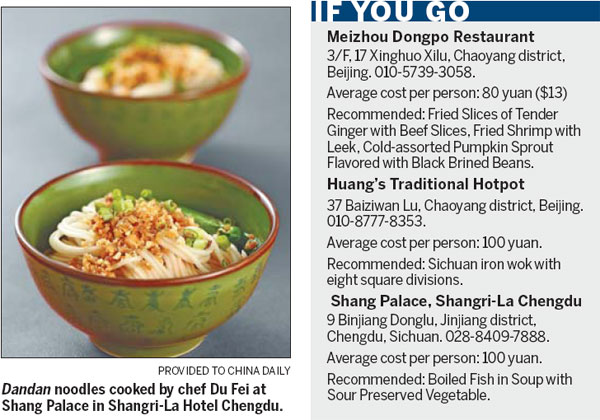

|
Chongqing hotpot with two soup bases at Huang Family Old Hotpot Restaurant. Ye Jun / China Daily |
Sichuan cuisine has come a long way in Beijing and continues to evolve with steady following. Ye Jun traces the fiery journey.
At a time when many restaurants see a decline in business, the long line at Meizhou Dongpo chain restaurants is enviable. The Sichuan food establishment has seen an 8-percent increase in business from January to May compared with the previous year.
A recent government's curb on spending with public funds has affected many high-end eateries in Beijing. But like Meizhou Dongpo, Sichuan cuisine seems to be an exception.
Salt, a restaurant offering Chongqing-style hotpot which opened recently, reflects the new trend.
Huang Ke, founder of Salt, says Chongqing hotpot caters mostly to the middle- and lower-income market.
Originally from Sichuan, he came to Beijing in 1983, and he has witnessed the development of Sichuan food in the capital city.
In 1950s, the only Sichuan restaurant was Sichuan Fandian in Dongrongxian Hutong, offering high-end Sichuan dishes. Sichuan dishes were also available at high-end places such as the Beijing Hotel.
In the 1990s, there were more Sichuan restaurants. With the reform and opening-up policy, there were more immigrants in the city including those from Sichuan province, who promoted the needs of their home-style cuisines.
Variety and good taste are what attract customers to many small Chongqing snacks restaurants on the street. But there were also restaurants like South Beauty that give Sichuan cuisine a face-lift by presenting classic Sichuan cuisine in Western style for business-oriented customers.
The development of Meizhou Dongpo chain restaurants in Beijing gives one an idea of how Sichuan restaurant has made it big in the capital city. The restaurant was founded by a Sichuan couple, who were ordinary chefs - one specializes in hot dish, another in cold dishes.
Since they set up the restaurant group in 1996, it has grown into a food conglomerate with more than 80 branches, specializing not just in Chinese food, but also hotpot, and traditional snacks.
Now Wang Gang, the husband, is the manager of the group. Liang Di, the wife, is in charge of creating new dishes, which she loves to do.
"The whole concept is to popularize high-end dishes, and make popular dishes finer," says Guo Xiaodong, deputy general manager of Meizhou Dongpo, emphasizing that lowering down the prices of dishes is one of their aims.
All the dishes they develop, according to Guo, are what common people like to see and eat.
Their new summer dishes include fresh and healthy combinations of the most ordinary ingredients, using classic recipe.
Among the dishes are fried slices of tender ginger and beef, with a bit of red chili, fried shrimp and leek. A very ordinary pumpkin sprout is served cold, flavored with black-brined beans.
The restaurant also serves some classic Si-chuan dishes that involve a complicated cooking process, which is why very few restaurants offer them.
The restaurant's signature Dongpo braised pork elbow needs three hours of cooking time to get rid of the fat and to remove the gelatin. A traditional delectable jujube cake is steamed for eight hours, and it costs only 19 yuan ($3).
Sichuan food has changed with time to adapt to people's changing preferences.
Traditionally, Chongqing hotpot uses tallow, and spicy, tongue-numbing ingredients including Sichuan peppercorn.
Huang Ke's Huang Family Old Hotpot Restaurant has replaced the tallow with clear vegetable oil, to reduce the greasiness.
He has also toned down the spiciness. But he still uses a very typical Sichuan iron wok with eight square divisions in which one can boil different ingredients.
Some classic ingredients for Sichuan hotpot still remain unacceptable to foreigners. For example, pork giblet, chitterling, pork blood bean curd, and pork brain.
That is why Du Fei, executive chef with Shang Palace, Shangri-La Hotel Chengdu, only uses ingredients most people can accept.
The 40-year-old Sichuan native became a chef 23 years ago.
"The chefs I met when I first started cooking were rather conservative in terms of the ingredients they use, and the way they cook," he says. "But now chefs are widely traveled. They have become more open-minded and dare to make changes."
Boiled fish in soup with sour preserved vegetable is a very traditional Sichuan dish. Traditionally, chefs cook the dish with pepper and black vinegar besides red pepper. Du has replaced it with yellow pepper sauce from Hainan, white Chinese pepper and Zhejiang vinegar. It makes the dish look more appetizing and still taste good.
Du says the trend of Sichuan cuisine has moved from strong tastes and fragrant aromas to healthy, original taste.
"Increasingly, people are asking for organic ingredients. At the same time, dishes have become more popularized, than high-end," he says.
Contact the writer at yejun@chinadaily.com.cn.
